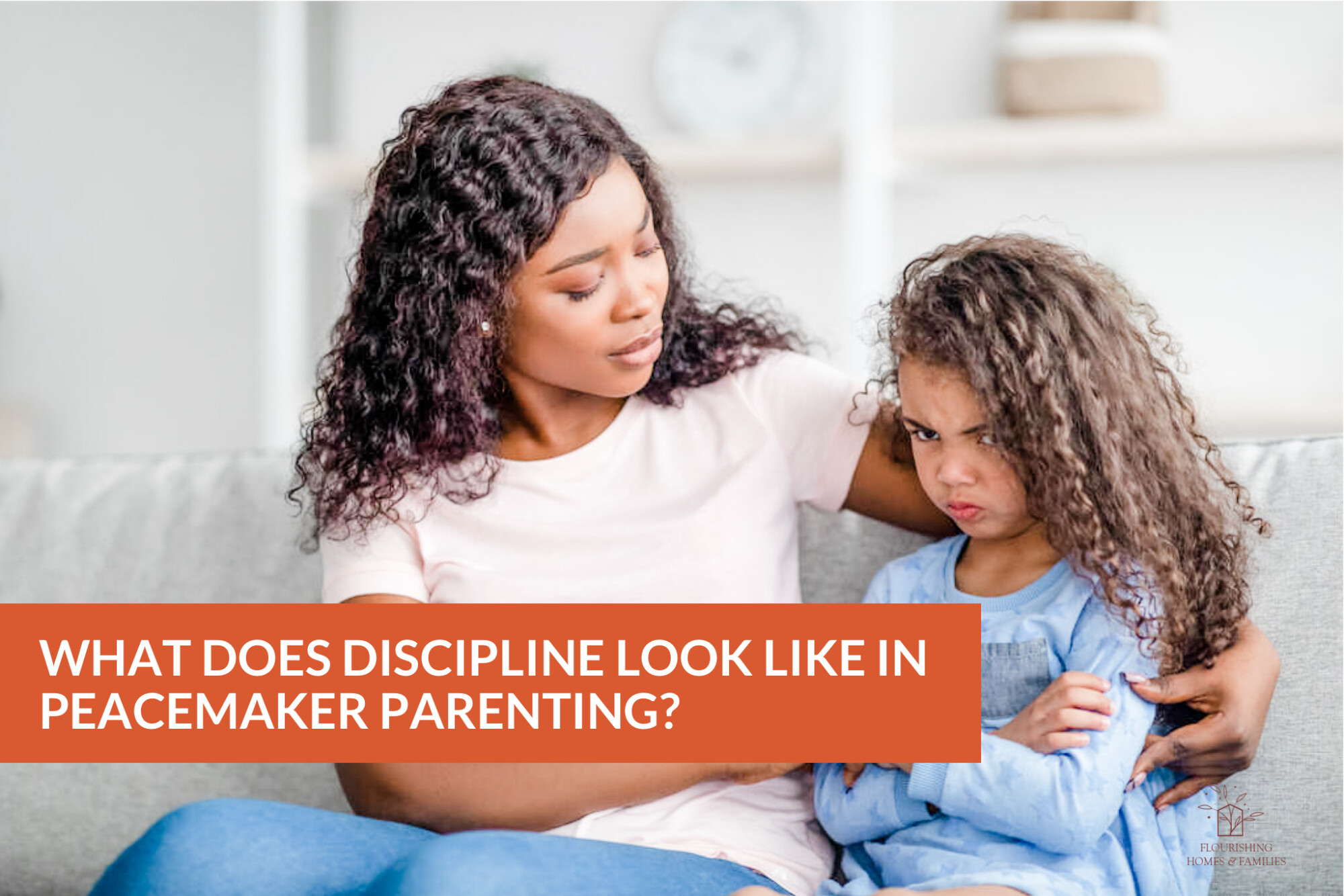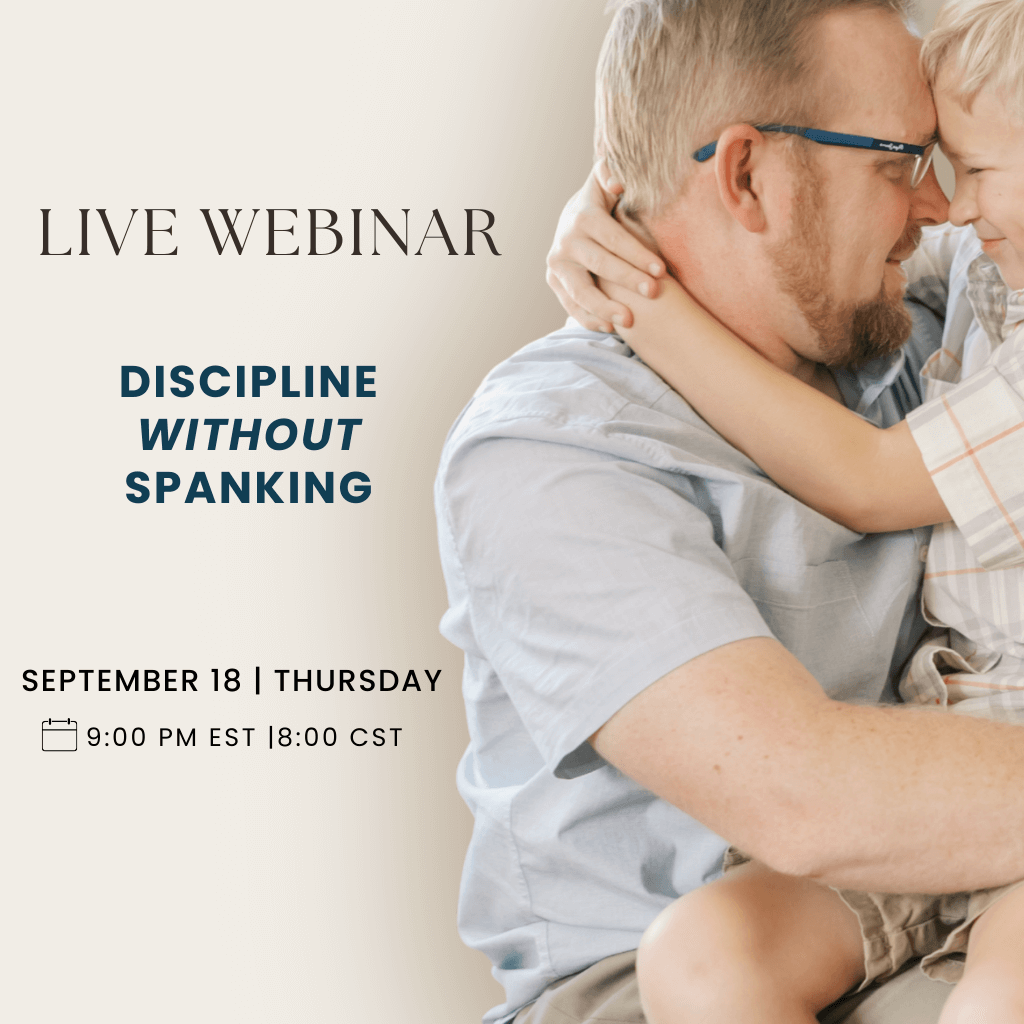When I think back on my experience transitioning into peacemaker parenting I can honestly say that it wasn’t hard at all to choose not to spank or use shame as a form of discipline.
The hard part came next…What on earth am I supposed to do instead?!

As parents, we are instructed to discipline our children and help equip them for life. But what does that look like when the goal is no longer control and compliance?
WHAT DOES DISCIPLINE LOOK LIKE IN PEACEMAKER PARENTING?
The short answer is: it looks like teaching. Teaching children to brush their teeth looks a lot like teaching them to ride a bike. Teaching children how to do conflict and disagreement well looks a lot like teaching them how to do math well. Teaching them how to navigate changing boundaries and limits looks like teaching them about changing seasons and social expectations for those seasons.
It takes time, modeling, practice, practice, practice, and more practice. We expect mistakes! We expect struggle. We expect forgetfulness. Not only from our children but sometimes from ourselves as well, because that's what being human looks like!
IN PEACEMAKER PARENTING, DISCIPLINE IS UNDERSTOOD AS DISCIPLESHIP
One thing you need to know: the majority of your discipline will not take place in the heat of the moment. Yes, there are times when intervention is needed in the moment to keep someone or something safe. But the actual teaching and training of what to do takes place later. Did you catch that? Discipline is about teaching. It's about discipleship, not behavior management. And the goal of discipline is to raise our children towards wisdom, discernment, Spirit-empowered obedience, and maturity.
Let's take a look at how gentle discipline is a means by which we R.A.I.S.E. our children towards maturity.

REGULATE
When the human brain is dysregulated, the learning centers are shut off, or at least slowed down. In Peacemaker Parenting, the goal is for discipline to happen after the child is regulated so that they can learn the lesson or skill that needs learning.
ASSESS
How you respond to your child in the moment largely depends on how urgent or unsafe the behavior is. Assessing for safety and/or injury will inform your response. (You will find that as children grow, the need for this assessment goes down because children become more aware of how their actions impact others.)
INSTILL
You aren't simply teaching a child not to hit their brother. You're instilling family values and kingdom ethics, and you're informing their self-identity and character. Peacemaker Parenting seeks not only to correct a child's misbehavior, it aims to instill core values in age-appropriate ways.
STUDY
Learning about child development will help you know how to guide them toward maturity. Peacemaker Parenting recognizes our expectation of a child's behavior must be reasonable within their developmental abilities. When we expect beyond that which they are capable, we risk exasperating and discouraging them - both of which we are commanded not to do (Colossians 3:21). We also study our child's unique personality, wiring, and temperament so that we provide opportunities to learn and grow in ways that best fit their needs.
EQUIP
The goal of discipline is to teach, train, disciple, and instruct. Children must be taught and equipped with tools and skills to know what to do instead of their impulsive, immature actions. Peacemaker Parenting invests in the child's future success by teaching them the skills and wisdom they are lacking, and allowing the time and space to practice (sometimes quite messily!) until they are confident in those skills.
When it comes to first steps if you’re anything like me, you need a bit of a strategy.
It’s not enough to know what not to do. We need to know what we are going to do when we are running low in both the caffeine and patience departments and a crisis breaks out. Spend some time reading through these ideas and practice what it will look like in your family.
- Use your calm body to help: This one requires a certain level and quite a bit of self-regulation. Sometimes a child might just need a gentle nudge in the right direction. Maybe you have a child refusing to brush their teeth (Been there!). Rather than threatening them with no story at bedtime, it might just take you gently helping them walk into the bathroom. You might even say something as you walk. Something like “you don’t want to brush your teeth right now, but it is my job to help your teeth grow healthy and strong so we are going to brush your teeth. Let me help you.” Your calm influence will help regulate their brains and bodies, which allows them to better follow directions, or collaborate and problem-solve. (A fun collaboration for brushing teeth is to allow your child to brush your teeth and then you brush their teeth!)
- Get to the heart of the issue: Maybe you have an older child who is not doing their chores properly. You know they are capable because they’ve done it well many times, but when you approach the subject with them they are disrespectful and cold. Could it be that they are feeling unmotivated or disappointed because it was a long winter and now it is warm and they would rather be outside? If you don’t ask, you may never know. There could be a simple thought process they just need a little help working through. Ask nonjudgmental questions in an empathetic way. The key is to stay calm and consistently show and tell them that you are always there to help.
- Offer a do-over: This is a beautiful demonstration of grace to our children. Do-overs are a no-pressure way to give a child a second (or third or fourth) chance to do what is expected. Bonus Tip: Turn into a playful robot or fairy to offer the Do-Over, it helps defuse tension! "Malfunction! Malfunction. Reprogramming. Beeep Booop. Do-over sequence initiated."
- Role-Playing: Role-playing allows children to practice tricky situations or challenging behaviors in low-pressure and neutral moments. Give them tools of what you want them to do instead, and then practice with them by playing pretend, practicing scripts, and switching roles.
- Story-Telling: Using stories is one of the most powerful ways to teach children. And we see the greatest disciple-maker, Jesus, using stories to teach important lessons all the time! Story-telling takes a child's particular struggle and redirects it to a relatable character, which allows them to learn without pressure, and even help problem solve.
If you're looking for more tools and strategies, our Peacemaker Parenting Workshop goes over these, and many more other approaches to disciplining our children with peace and gentleness. And our Peacemaker Parenting Scripts E-Book contains more than 70 sample scripts to help you respond to your children with grace and confidence.
 |  |













0 Comments